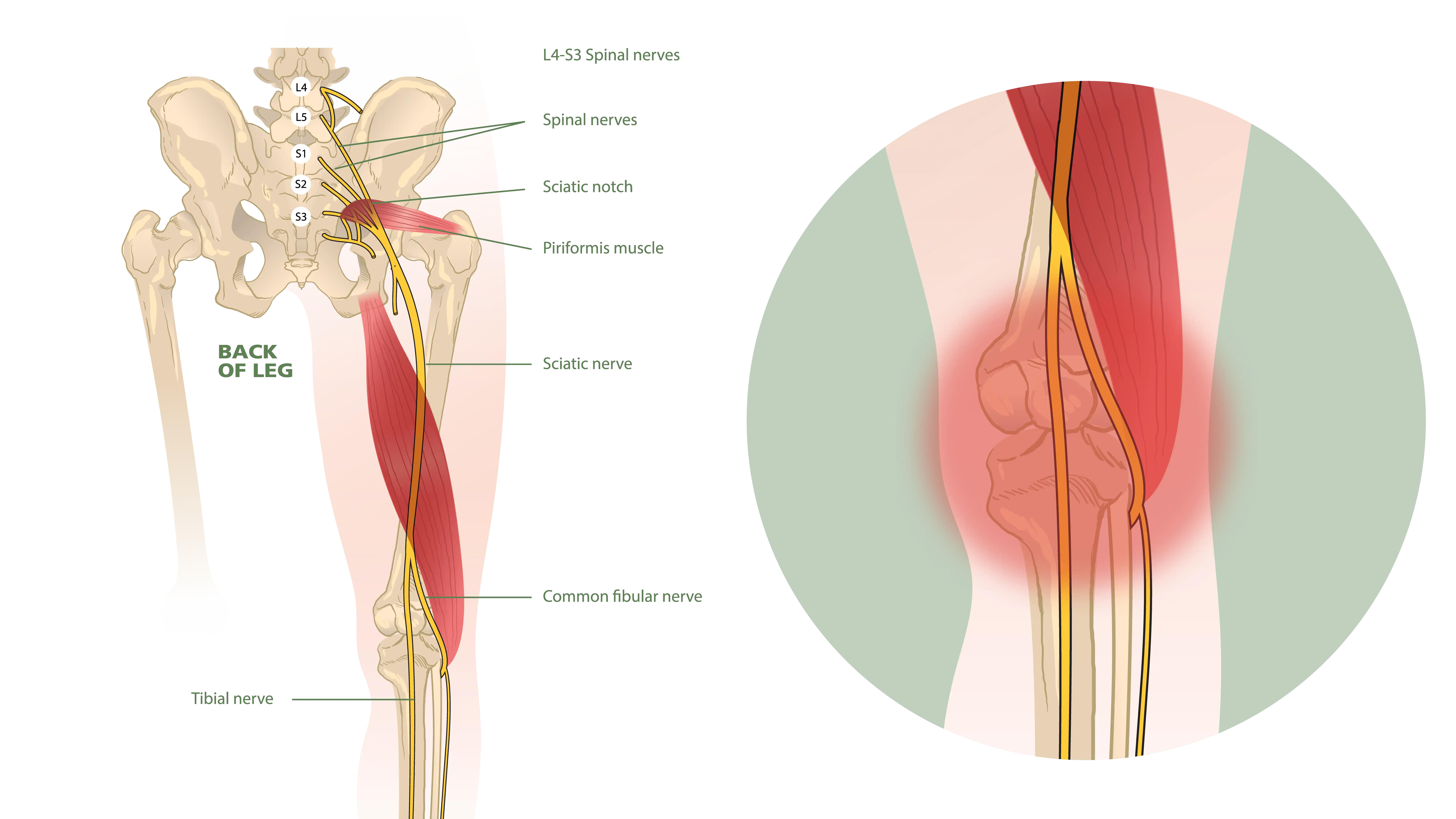If you’re wondering whether sciatica can cause knee pain, the short answer is yes. When the sciatic nerve is irritated or compressed, it may cause pain that radiates to the knee. In this post, we’ll explore how sciatica may lead to knee pain, its symptoms, and available treatments.
Key Takeaways
- Sciatica-related knee pain often stems from lower back issues affecting the sciatic nerve, with symptoms including sharp pain and knee weakness.
- Diagnosis typically involves a thorough evaluation, including physical examinations and imaging tests, to distinguish sciatica-related knee pain from other causes.
- Treatment options for sciatic knee pain include physical therapy, medications, and corticosteroid injections, with early intervention often leading to better outcomes.
How Sciatica Can Lead to Knee Pain
The sciatic nerve plays a key role in sending signals to the leg and foot. When this nerve is irritated or compressed, it can lead to knee pain. This discomfort often arises from issues in the lower back, which affect the sciatic nerve and subsequently cause pain in the knee.

Compression or irritation of the L4 spinal nerve root can directly impact the knee, often leading to significant discomfort. Additionally, nerve irritation from conditions like tight hamstrings or other lower back problems can exacerbate the stress on the sciatic nerve, further heightening knee pain. Understanding these connections is the first step toward finding effective treatment and relief.
Recognizing Sciatica Symptoms in the Knee
Proper diagnosis and treatment depend on recognizing the symptoms of sciatica-caused knee pain. Common symptoms include sharp pain, a dull ache, and knee weakness. These sensations can vary in intensity and may present as a burning or shooting pain.
Knee weakness is another possible symptom, often manifesting as difficulty putting weight on the knee or a sensation that the knee might give way. This instability can negatively affect daily activities, including walking and standing for extended periods.
Often, knee pain related to sciatica is accompanied by lower back pain. This correlation highlights the condition’s severity and helps distinguish sciatica from other causes of knee pain. Recognizing these symptoms early can lead to more effective management and treatment strategies.
Diagnosing Sciatica-Related Knee Pain
Diagnosing sciatica-related knee pain involves a thorough evaluation by an experienced orthopedic surgeon. This typically includes physical examinations, a review of the patient’s medical history, and tests for reflexes and muscle strength. Imaging tests such as MRI or X-rays may also be used to get a detailed view of the spine and the affected nerves.
If knee pain is persistent, severe, and limits movement, it is important to seek evaluation. Additionally, if the pain does not improve with home care after a couple of weeks, it is a sign that medical consultation is needed.
A specialist’s assessment can help differentiate knee pain caused by sciatica from other potential causes, supporting accurate diagnosis and appropriate treatment.
Effective Treatments for Sciatic Knee Pain
Once diagnosed with sciatica-related knee pain, several treatment options can be explored to alleviate symptoms and improve quality of life. These include physical therapy, medications, and corticosteroid injections. If these conservative treatments fail to provide sufficient relief, surgery may be indicated.
Early treatment is key to effectively managing sciatic knee pain. Early intervention can prevent the condition from worsening and help maintain mobility and function.
Physical Therapy
Physical therapy plays an essential role in treating sciatica-related knee pain. It helps strengthen muscles and improve flexibility, both of which can help alleviate sciatica symptoms. Strengthening core muscles, in particular, provides better support for the sciatic nerve, reducing the likelihood of irritation and pain.
Specific exercises recommended by physical therapists include pelvic tilts, abdominal bracing with floor marches, seated hamstring stretches, bridge marches, and glute bridges. These exercises focus on enhancing posture, strengthening core muscles, and improving flexibility.
Physiotherapy services may include exercise therapy, massage for relief, and manual therapy. These treatments are designed to target the affected areas and provide relief from sciatic knee pain.
If unsure about the best movements for sciatic knee pain, consider booking an appointment with a physiotherapist. They can develop a personalized exercise program tailored to your specific needs and goals.
Medications and Pain Relievers
Medications and pain relievers are commonly used to manage sciatic knee pain. Over-the-counter options such as ibuprofen and acetaminophen can provide relief from pain and inflammation. Prescription medications may be recommended for more severe pain. These can include muscle relaxants and nerve pain medications.
These medications can help alleviate sharp pain and dull aches, making it easier to manage daily activities and relieve pressure. However, it is important to consult your doctor to determine the most appropriate medication for your specific condition.
Corticosteroid Injections
Corticosteroid injections are another treatment option for sciatic knee pain. These injections work by reducing inflammation and relieving pain associated with sciatica. They are typically considered when other treatments, such as medications and physical therapy, do not provide adequate pain control.
The injections can provide significant short-term relief, allowing individuals to regain mobility and function. However, it is essential to discuss the potential benefits and risks with a healthcare provider before proceeding with this treatment.
Preventing Sciatica from Causing Knee Pain
Preventing sciatica from causing knee pain involves adopting healthy habits and lifestyle changes. Practicing good posture may help reduce the risk of developing sciatic knee pain by minimizing strain on the back and legs.
Maintaining an active lifestyle can also help manage and prevent sciatica symptoms. Engaging in gentle exercises like the glute bridge and bird-dog can improve mobility and alleviate sciatic discomfort. Stretching routines at least twice weekly are also beneficial for sciatica management.
Building core strength can help support the lower back, reducing the risk of sciatica-related knee pain. Recommended gentle exercises for sciatica include swimming, stretching, and walking. These activities help maintain overall fitness and can prevent the onset of sciatica symptoms.
When to Seek Medical Advice
Consider seeking medical advice if severe leg or lower back pain prevents movement or if there is no improvement after a week or two of home treatment. Consulting an orthopedic surgeon for evaluation can help determine if sciatica is causing your knee pain.
Summary
Understanding the connection between sciatica and knee pain can support more effective management and treatment. By recognizing the symptoms, seeking a timely diagnosis, and exploring various treatment options, individuals can find relief from this condition.
Taking proactive steps to prevent sciatica from causing knee pain, such as maintaining proper posture, staying active, and strengthening core muscles, can make a significant difference. With the right knowledge and approach, managing sciatica-related knee pain is possible.
Frequently Asked Questions
Can sciatica cause knee pain?
Yes, sciatica can cause knee pain due to irritation or compression of the sciatic nerve, which may lead to discomfort in the knee area.
What are the common symptoms of sciatic knee pain?
Common symptoms of sciatic knee pain include sharp or dull aches, knee weakness, and unusual sensations such as burning or shooting pain. Recognizing these signs early can help in seeking appropriate treatment.
How is sciatica-related knee pain diagnosed?
Sciatica-related knee pain is diagnosed through physical examinations, reviewing medical history, conducting reflex and muscle strength tests, and utilizing imaging tests such as MRI or X-rays. These steps help ensure an accurate diagnosis.
What are the treatment options for sciatic knee pain?
For sciatic knee pain, effective treatment options include physical therapy, medications, and corticosteroid injections, aimed at alleviating discomfort and improving function.
How can I prevent sciatica from causing knee pain?
To prevent sciatica from causing knee pain, focus on maintaining proper posture, staying active, and strengthening your core through gentle exercises. Prioritizing these practices may help alleviate discomfort and reduce the risk of flare-ups.





